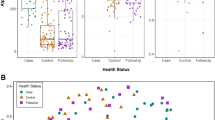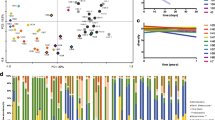Abstract
Epidemiological data suggest that ceftriaxone may promote the emergence of commensal AmpC-overproducing Enterobacteriaceae because of a high biliary excretion. We tested this hypothesis in hospitalized patients either treated by ceftriaxone alone or receiving no antibiotics. Hospitalized patients with no previous antibiotics or hospitalization in the last 3 months, treated only with ceftriaxone, were prospectively included. For each ceftriaxone-treated patient, a control patient receiving no antibiotics was included. Clinical data and stools were collected at T0 (before antibiotics) and T1 (at the end of ceftriaxone treatment or at discharge) and T2 (3–6 months after T1) for the ceftriaxone-treated patients and at T0 and T1 for control patients. Third-generation cephalosporin-resistant Enterobacteriaceae were detected, identified by matrix-assisted laser desorption/ionization time-of-flight (MALDI-TOF), and characterized genetically. Clonal relatedness was evaluated by random amplified polymorphic DNA-polymerase chain reaction (RAPD-PCR). Fifteen ceftriaxone and 22 control patients were included. Patients’ characteristics did not differ. At T0, 2/15 ceftriaxone-treated versus 1/22 control patients carried third-generation cephalosporin-resistant Enterobacteriaceae (p = 0.6). At T1, 4/15 (27%) ceftriaxone-treated patients carried AmpC producers versus 0/22 control patients (p = 0.02). Additionally, two and three subjects carried extended-spectrum β-lactamase (ESBL)-producing Enterobacteriaceae in the ceftriaxone and control groups, respectively (p = 1). At T2, three ceftriaxone-treated patients still carried AmpC-producing Enterobacteriaceae with the same RAPD profile as at T1. In hospitalized subjects with no other selective pressure, treatment by ceftriaxone alone promotes the gut colonization by AmpC-overproducing Enterobacteriaceae in over a quarter of patients, with a persistent carriage after the end of antibiotic exposure. The ecological impact of ceftriaxone should not be underestimated.
Similar content being viewed by others
References
Jacoby GA (2009) AmpC beta-lactamases. Clin Microbiol Rev 22:161–182. https://doi.org/10.1128/CMR.00036-08
Pitout JDD, Laupland KB (2008) Extended-spectrum beta-lactamase-producing Enterobacteriaceae: an emerging public-health concern. Lancet Infect Dis 8:159–166. https://doi.org/10.1016/S1473-3099(08)70041-0
Nordmann P, Naas T, Poirel L (2011) Global spread of carbapenemase-producing Enterobacteriaceae. Emerg Infect Dis 17:1791–1798. https://doi.org/10.3201/eid1710.110655
Grohs P, Kernéis S, Sabatier B, Lavollay M, Carbonnelle E, Rostane H et al (2014) Fighting the spread of AmpC-hyperproducing Enterobacteriaceae: beneficial effect of replacing ceftriaxone with cefotaxime. J Antimicrob Chemother 69:786–789. https://doi.org/10.1093/jac/dkt403
Muller A, Lopez-Lozano JM, Bertrand X, Talon D (2004) Relationship between ceftriaxone use and resistance to third-generation cephalosporins among clinical strains of Enterobacter cloacae. J Antimicrob Chemother 54:173–177. https://doi.org/10.1093/jac/dkh282
Fantin B, Duval X, Massias L, Alavoine L, Chau F, Retout S et al (2009) Ciprofloxacin dosage and emergence of resistance in human commensal bacteria. J Infect Dis 200:390–398. https://doi.org/10.1086/600122
de Lastours V, Cambau E, Guillard T, Marcade G, Chau F, Fantin B (2012) Diversity of individual dynamic patterns of emergence of resistance to quinolones in Escherichia coli from the fecal flora of healthy volunteers exposed to ciprofloxacin. J Infect Dis 206:1399–1406. https://doi.org/10.1093/infdis/jis511
Drieux L, Brossier F, Sougakoff W, Jarlier V (2008) Phenotypic detection of extended-spectrum β-lactamase production in Enterobacteriaceae: review and bench guide. Clin Microbiol Infect 14:90–103. https://doi.org/10.1111/j.1469-0691.2007.01846.x
Dallenne C, Da Costa A, Decré D, Favier C, Arlet G (2010) Development of a set of multiplex PCR assays for the detection of genes encoding important beta-lactamases in Enterobacteriaceae. J Antimicrob Chemother 65:490–495. https://doi.org/10.1093/jac/dkp498
Pérez-Pérez FJ, Hanson ND (2002) Detection of plasmid-mediated AmpC beta-lactamase genes in clinical isolates by using multiplex PCR. J Clin Microbiol 40:2153–2162
Martin B, Garriga M, Hugas M, Aymerich T (2005) Genetic diversity and safety aspects of enterococci from slightly fermented sausages. J Appl Microbiol 98:1177–1190. https://doi.org/10.1111/j.1365-2672.2005.02555.x
de Lastours V, Chau F, Roy C, Larroque B, Fantin B (2014) Emergence of quinolone resistance in the microbiota of hospitalized patients treated or not with a fluoroquinolone. J Antimicrob Chemother 69:3393–3400. https://doi.org/10.1093/jac/dku283
Tacconelli E, Cataldo MA, Dancer SJ, De Angelis G, Falcone M, Frank U et al (2014) ESCMID guidelines for the management of the infection control measures to reduce transmission of multidrug-resistant Gram-negative bacteria in hospitalized patients. Clin Microbiol Infect 20(Suppl 1):1–55. https://doi.org/10.1111/1469-0691.12427
de Lastours V, Bleibtreu A, Chau F, Burdet C, Duval X, Denamur E et al (2014) Quinolone-resistant Escherichia coli from the faecal microbiota of healthy volunteers after ciprofloxacin exposure are highly adapted to a commensal lifestyle. J Antimicrob Chemother 69:761–768. https://doi.org/10.1093/jac/dkt422
Ruppé E, Armand-Lefèvre L, Estellat C, Consigny PH, El Mniai A, Boussadia Y et al (2015) High rate of acquisition but short duration of carriage of multidrug-resistant Enterobacteriaceae after travel to the tropics. Clin Infect Dis 61:593–600. https://doi.org/10.1093/cid/civ333
Acknowledgements
This work was presented as a poster at the 27th European Congress on Clinical Microbiology and Infectious Diseases (ECCMID) meeting (Vienna, Austria, 22–25 April 2017).
Funding
The research leading to these results has received funding from the European Union (EU) FP7 health program Evolution and Transfer of Antibiotic Resistance (EvoTAR #282004).
Author information
Authors and Affiliations
Corresponding author
Ethics declarations
Conflict of interest
All authors declare they have no conflict of interest concerning this work.
Ethical approval
This work was approved by the French National Institutional Review Board (IRB 00008522; clinical trial: NCT02031588).
Informed consent
All patients gave informed consent, according to French Law and the approval from the French National Institutional Review Board (IRB 00008522).
Rights and permissions
About this article
Cite this article
de Lastours, V., Goulenok, T., Guérin, F. et al. Ceftriaxone promotes the emergence of AmpC-overproducing Enterobacteriaceae in gut microbiota from hospitalized patients. Eur J Clin Microbiol Infect Dis 37, 417–421 (2018). https://doi.org/10.1007/s10096-018-3186-x
Received:
Accepted:
Published:
Issue Date:
DOI: https://doi.org/10.1007/s10096-018-3186-x




